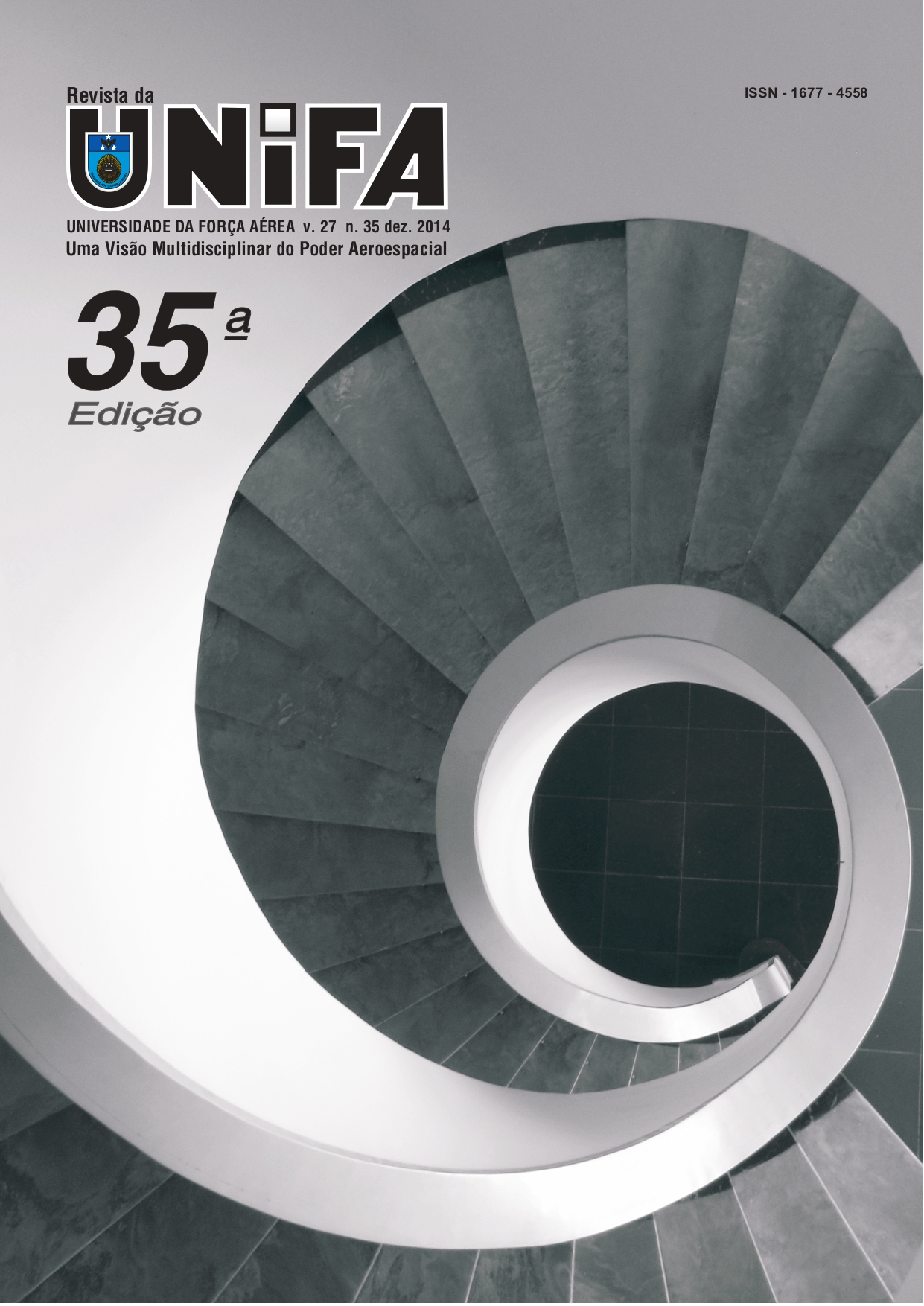Improvement of a spatial disorientation simulator based on the concept of Bárány
DOI:
https://doi.org/10.22480/revunifa.2014.27.573Keywords:
Simulator, Spatial disorientation, Concept of Bárány, Air accidentAbstract
Spatial disorientation is a condition in which a pilot is unable to accurately determine the aircraft position relative to the airspace surrounding it or to the ground surface, putting at risk the flight safety. All individuals are susceptible to this experience, especially when flying at night or in adverse weather conditions. Therefore, this project aimed to make improvements to a Spatial Disorientation Simulator (SDS) based on the concept of Bárány, to facilitate pilot training and enable aerospace physiology research to take place. To this end, a survey was conducted on the limitations presented by the control software and hardware, and on the mechanical structure of the existing MicroG Centre simulator, from which were identified those features requiring improvement. The resultant SDS is equipped with magnetic braking, direction reversal and fine
control of speed and acceleration, features found only in this version of the simulator, which enabled it to meet the needs established by aerospace physiology study protocols. This work results from more than a decade of experience conducting research in spatial disorientation, for which international recognition has been achieved. The data presented demonstrated the positive impact of the improvements achieved in conducting clinical-physiological research.
References
ALVES, C. V. Desenvolvimento de um sistema para quantificação da desorientação espacial. 2008. Dissertação (Mestrado) - Departamento
de Engenharia Elétrica, Pontifícia Universidade Católica do Rio Grande do Sul, 223p.
BENSON, A. J. Orientation/disorientation training of flying personnel: a working group report. ADVISORY GROUP FOR AEROSPACE
RESEARCH AND DEVELOPMENT NEUILLY-SURSEINE (FRANCE), 1974.
BENSON, A. J.; DIAZ, E.; FARRUGIA, P. The perception of body orientation relative to a rotating linear acceleration vector. Fortschritte der
Zoologie, v. 23, n. 1, p. 264, 1975.
BENSON, A. J., Human control performance and tolerance, with a preliminary historical review of flight simulation, CC Clark - National Meeting on Manned Space Flight, 1998.
BYUN, J. Y. et al. Role of subjective visual vertical test during eccentric rotation in the recovery phase of vestibular neuritis. Auris Nasus Larynx, v. 37, n. 5, p. 565-569, 2010.
CLARK, B. Disorientation incidents reported by military pilots across fourteen years of flight. In: The Disorientation Incident. Conference Report CP. 1971. p. A1.
CLARK, B.; GRAYBIEL, A. Disorientation: A cause of pilot error. Bureau of Medicine and Surgery Research Report No. NM, v. 1, n. 110, p. 100, 1955.
CLARK, B.; NICHOLSON, M. A.; GRAYBIEL, A. Fascination: a cause of pilot error. Journal of Aviation Medicine, v. 24, n. 5, p. 429-440, 1953.
ENTICOTT, J. C.; O’LEARY, S. J.; BRIGGS, R. J. S. Effects of vestibulo-ocular reflex exercises on vestibular compensation after vestibular schwannoma surgery. Otology & Neurotology, v. 26, n. 2, p. 265-269, 2005.
EMBRY-RIDDLE. GAT-II Spatial Disorientation Flight Training Device. 2014. Disponível em: <http://daytonabeach.erau.edu/about/fleetsimulators/the-gat-II/index.html>. Acesso em: 06 nov. 2014.
FLACK, M.; BOWDLER, A. P. The medical problems of flying. Medical Research Council, Special Report Series, n. 53, 1920.
GESSINGER, R. P. Aperfeiçoamento da cadeira eletricamente controlada e seu uso no estudo do equilíbrio humano. 2005. 103f. Dissertação (Mestrado em Engenharia Biomédica) – Faculdade de Engenharia, Programa de Pós-Graduação em Engenharia Elétrica, Pontifícia Universidade Católica do Rio Grande do Sul, Porto Alegre.
KIRKHAM, W. R. et al. Spatial disorientation in general aviation accidents. Aviation, space, and environmental medicine, 1978.
KO, J.S. et al. Precision speed control of PMSM for stimulation of the vestibular system using rotatory chair. Mechatronics, v. 13, n. 5, p. 465-475, 2003.
PARKER, D. E. The vestibular apparatus. Scientific American, 1980.
PIEDADE, L. A.; RUSSOMANO, T. Cadeira de Bárány como modelo de desorientação espacial. 2001. 101 f. 2001. Dissertação (Mestrado em
Engenharia)-Faculdade de Engenharia, Programa de Pós-Graduação em Engenharia Elétrica, Pontifícia Universidade Católica do Rio Grande do Sul, Porto Alegre.
RUSSOMANO, T. et al. Aperfeiçoamento e validação de simulador de desorientação espacial. Revista Brasileira de Engenharia Biomédica,
p. 97-103.
RUSSOMANO, T. Fisiologia aeroespacial: conhecimentos essenciais para voar com segurança. EDIPUCRS, 2012.
STEELE-PERKINS, A. P.; EVANS, D. A. Disorientation in naval helicopter pilots. In Operational Helicopter Aviation Medicine.
Conference Proceedings CP 255, 48, 1-5. Neuilly sur Seine: AGARD/NATO, 1978.
SUBASINGHE, T.; GREEN, D. A.; RUSSOMANO, T. Impact of Spatial Disorientation on Concurrent Cognitive Tasks. 2013. 47 f. 2013. Dissertação de Mestrado, School of Biomedical Science, King’s College London, Londres, Reino Unido.
TORMES, F. R.; GUEDRY, F. E. Disorientation phenomena in naval helicopter pilots. Pensacola, FL: US Naval Aerospace Medical Research
Laboratory. Report, 1974.
TREDICI, T. J. Visual illusions as a probable cause of aircraft accidents. Spatial Disorientation in Flight: Current Problems, 1980.
VESTICON. Epley Omniax® System. 2014. Disponível em:< http://www.vesticon.com/epleyomniax-system>. Acesso em: 06 nov. 2014.
Downloads
Published
Issue
Section
License
Copyright (c) 2014 Thais Russomano, Luiz Alberto Piedade, Paulo Antônio Guimarães Lanzini Lopes, Ingrid Gradaschi Lamadrid, Leandro Disiuta, Ricardo Bertoglio Cardoso, Júlio César Marques de Lima, Cloer Vescia Alves

This work is licensed under a Creative Commons Attribution-NonCommercial 4.0 International License.
Revista da UNIFA permite que o (s) autor (es) mantenha(m) seus direitos autorais sem restrições. Atribuição-NãoComercial 4.0 Internacional (CC BY-NC 4.0) - Revista da UNIFA é regida pela licença CC-BY-NC









